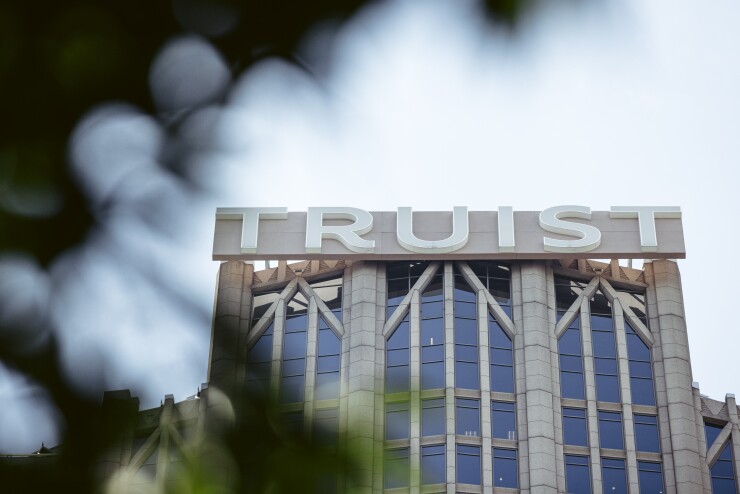
Truist Financial has reset its outlook for a key profitability metric, seemingly acknowledging that some of the expected benefits from the merger that formed the company have not materialized.
Nearly two months after signaling that a revision was coming — and a year after
The latest guidance compares with a low-20s percentage return on tangible common equity target that Truist had been trying to reach since the
Truist's return on tangible common equity was 10.4% in the second quarter of this year, 16.3% in the first quarter and 18.9% for full-year 2023, according to filings.
The reset is necessary because of two developments since the merger —
That's on top of a bounty of
"We came out of the merger very pleased with what our teammates were able to accomplish and what we were able to accomplish with our clients," Rogers said. "But we came out with a chassis that was too big … and we could have taken that over a long burn. But we made the decision, 'Let's just do a reset. Let's actually take more of a stair-step function.'"
Missed profitability targets have been common for Charlotte, North Carolina-based Truist since the merger. In February 2019, when the BB&T-SunTrust deal was announced, executives at the two banks said they expected the combined company to achieve a return on tangible common equity of 22% by 2022.
As it turned out, Truist's return on tangible common equity did top 22% in 2022 — it was 22.9% for the year — but that's the only year in which the company has surpassed 20%. Return on tangible common equity is a metric that shines a light on a bank's overall performance.
Back in 2019, BB&T and SunTrust executives also projected that Truist would reach a 51% efficiency ratio, achieved partly through cost savings of $1.6 billion, by 2022. The company's adjusted efficiency ratio for 2023 was 58.8%, and its unadjusted efficiency ratio was even higher.
Last summer, Wells Fargo analyst Mike Mayo called on Truist to reduce expenses, own up to financial-target shortfalls, overhaul its board of directors and rethink its incentive compensation.
A few weeks later, as
By October,
Then in February, Truist announced a deal to
In a research note published Tuesday, Mayo wrote that he expects Truist's profitability returns to improve, but that "even higher levels from here are far short of the original merger" targets.
He said that "pressure should remain on management to perform after merger shortfalls," writing that Truist's efficiency ratio will "likely remain far above its pre-merger target of 51%" and noting that the new return on tangible common equity target "seems close to [the] current run-rate" and a "low bar."
Rogers spent some time Tuesday outlining his vision for improved profitability.
A path to stronger returns should come from growth in clients and businesses — including middle-market banking, treasury management and wealth management — as well as a more efficient balance sheet and maintaining cost discipline, he said. The company plans to drive more business by "more fully servicing existing, satisfied clients," he said.
Truist still expects to keep its expenses flat this year after they rose about 7% in 2023. It plans to deploy some of its capital by repurchasing $500 million of common shares in the third and fourth quarters, under an overall repurchase authorization plan of $5 billion through 2026.
"To be clear, we think this is a key differentiating factor for Truist, as we believe that investors in our common stock today have the opportunity to receive a relatively higher capital return from our strong common stock dividend and share repurchase over the next several years, and also continuing to own a franchise in attractive markets poised to deliver growth," Rogers said.
Shares in Truist fell about 1.6% on Tuesday. Year to date, the stock price is up nearly 14%.






